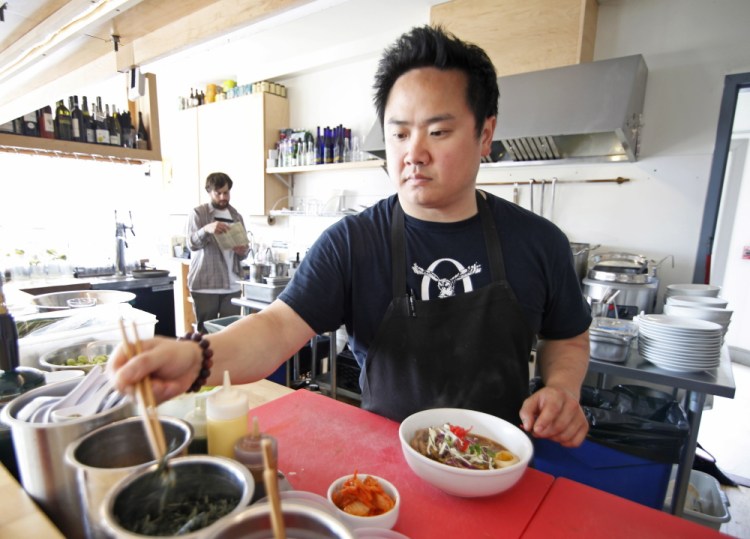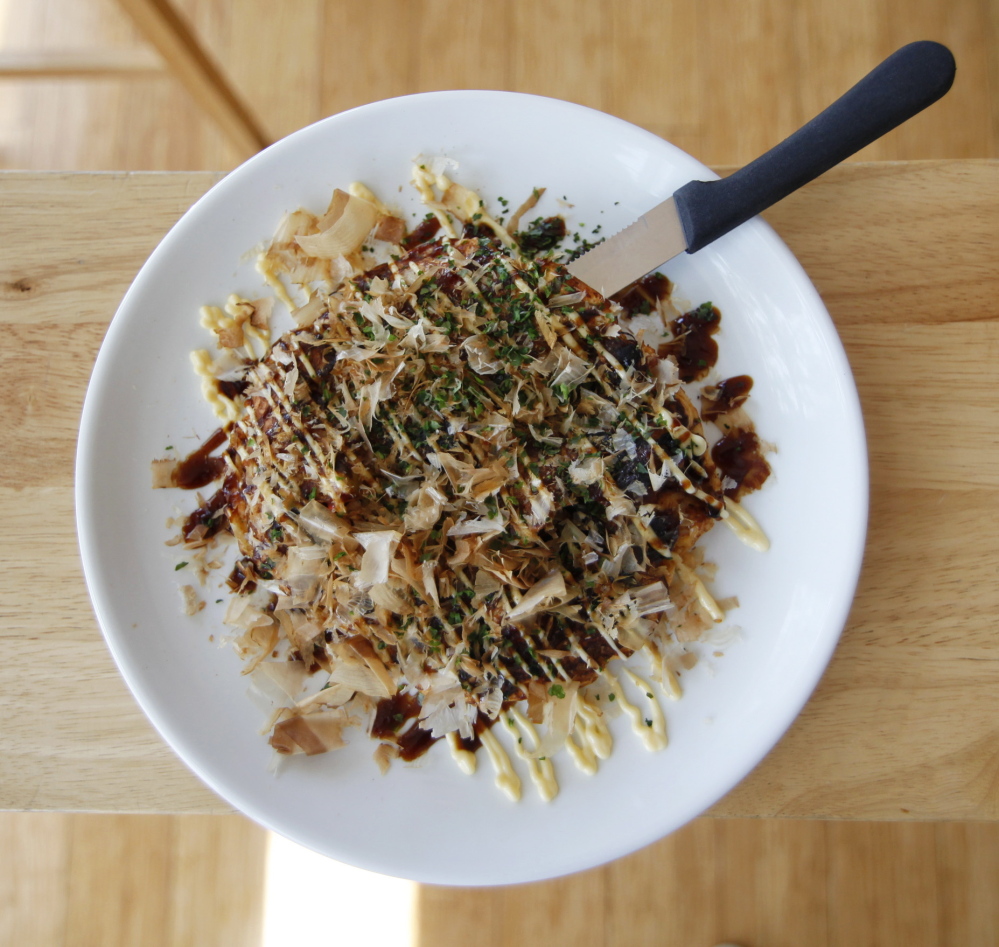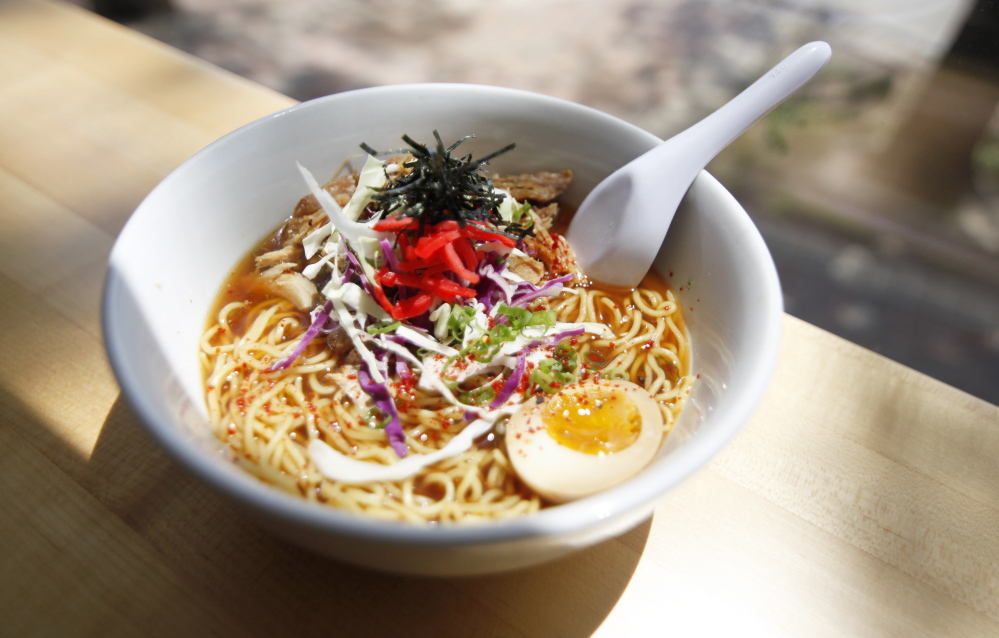In life, and in restaurants, there’s a place for the predictable: We all crave comfort and familiarity to some degree. But there’s also space for the unexpected – the discovery that delivers a tiny jolt of pleasure at something distinctly different or entirely surprising. That’s what I experienced at Anju Noodle Bar in Kittery Foreside – a sense of excitement over a meal that left me intrigued, impressed and hungry for more.
The restaurant is tiny, with just 38 seats squeezed into about 670 square feet of bright, open space. And the kitchen, staffed with three cooks every evening, is about as big as the galley in an average Brooklyn walkup. But, oh, what dishes those cooks prepare! From house-made kimchi to pork belly pancakes, duck confit to ramen bowls, each serving is artfully assembled, sautéed, seared or steamed to order, and infused with the fragrant spices of Asia. Anju (co-executive chefs Julian Armstrong and Gary Kim say the Korean word connotes tasty dishes “designed to be consumed in a convivial atmosphere”) isn’t just another noodle bar and the food isn’t classically Korean. It’s an innovative neighborhood restaurant with a constantly changing menu that draws from the cuisines of many countries but focuses on a single objective: flavor.
Following the suggestion of the terrific and well-informed waitress (staff so thoroughly conversant with the menu is a big asset), we started with napa cabbage kimchi ($4). It’s where Armstrong and Kim started, too. They began making kimchi as a hobby and selling it at the Kittery farmers market. “We worked so well together and shared such similar food passions,” Armstrong says, “that we decided to found SonMat Foods, a wholesale company, and eventually a brick-and-mortar restaurant.”
Fresh and crunchy, piquant instead of smoldering, slightly sweet (they add chunks of Asian pear as a natural preservative), the kimchi ($4) is intensely aromatic with whiffs of garlic and ginger and the sharp scent of chives. Bits of daikon radish and carrots add crunch. If you’ve already tried kimchi, you’ve probably formed an opinion: Fermented cabbage tends to evoke strong feelings. But whatever your previous experiences, try the version at Anju. It’s compulsively good.
Nearly as habit-forming was the shrimp toast ($10) – not the greasy, deep-fried version found at too many Chinese restaurants (Long on starch. Short on seafood), but a hearty baguette from Beach Pea Baking Co. in Kittery slathered with a garlicky shrimp paté, toasted in butter, then finished in the oven and topped with a few slices of, wait for it, prosciutto. Unorthodox? Certainly. Still, the combination was mouthwatering. We savored the flavors in each bite – the crisp round of bread, the chili-spiced shrimp, a hint of depth from fish sauce and a burst of saltiness from ham. This was cross-cultural cooking destined to surprise. And I was wowed.
Until the waitress brought over a plate of okonomiyaki ($10), a Japanese pancake topped with poached shrimp, pork belly and scallions. Suddenly, my friends pushed their chairs away from the table. “Is something on that plate alive?” one asked. He had a point. The surface of the cake was waving rhythmically with tiny ribbons reminiscent of kelp dancing in the depths of the ocean. This was unexpected – and more than a little unnerving. Sensing alarm, the attentive waitress returned and smiled broadly: “Don’t worry,” she said, “It’s bonito,” the paper-thin slices of smoked, dried tuna that are traditionally scattered over the pancake. The heat from the dish makes the bonito flutter – a mesmerizing display we watched until the pancake (and our nervousness) cooled and hunger kicked in. The dish tasted as tantalizing as it looked, the seafood and pork drizzled with a savory barbecue sauce and rich, creamy Japanese Kewpie mayo. Much like the prosciutto atop the shrimp toast, the bonito provided a spark of saltiness.
Anju had me. Our appetizers were expertly prepared, deeply flavorful and (in at least one case) frighteningly good. If entrees hadn’t been streaming out of the kitchen and capturing our attention we might have been tempted to order a few more starters and call them dinner. I’m glad we didn’t.
Shoyu ramen ($13), the restaurant’s flagship dish, was satisfying. The kitchen roasts pork and chicken bones for about a day with ginger and garlic in order to make a rich, viscous broth that’s flavored with chili peppers, soy seasoning and rice wine. Armstrong says he buys the chewy noodles from Sun Noodle, “hands down the best ramen producer in the country.” (“A delivery guy from Massachusetts brings the noodles directly to us,” Armstrong says. “It sometimes feel like a weird drug deal.”) They’re topped with silken shreds of roasted pork and a garnish of pickled ginger. My favorite morsel was the poached egg in the bowl. Marinated in soy, sake and mirin, it was still soft inside. Poked with a chopstick it added richness to the bowl and flavor to the broth.
The ramen was good – soothing rather than stunning – but the waitress raised an eyebrow as she set down a plate of duck yakisoba ($15), daring us to resist the mound of thick, curling noodles stir fried in a tangy ponzu sauce and showered with sliced scallions, cashews and sesame seeds. I twirled the noodles onto my chopsticks and speared a dripping piece of duck confit. The meat was tender and moist, bathed in the same dark brown sauce covering the noodles. (I had to resist licking my fingers.) Making the sauce bright – was it orange juice? Lemon? “Both,” Armstrong says. “We try to keep the taste a bit subtle…we don’t want any one thing to be too prominent.”
If you go to Anju and try one dish – which would be a shame – ask about the duck. It may not always be on the menu. Kim and Armstrong make weekly and seasonal changes letting both the growing season and the market direct their choices. “We want people to come in several times a week and have vastly different kinds of dinners,” Armstrong says. ” They shouldn’t feel that they’ll have exactly the same experience every time – unless they want to.”
Anju isn’t perfect. The dining room is noisy. The chopsticks are plastic. You can’t make reservations for smaller parties, and you’ll likely wait a few minutes before being seated at rush hour. But the noodle bar has an excellent sense of self. It’s small. It’s busy. It’s crowded. And the food is unexpectedly, unforgettably fabulous.
James H. Schwartz has covered food, travel and architecture for The Washington Post, Downeast, Coastal Living and Southern Living magazines for more than 30 years. Long a commuter between Portland and Washington, D.C., he retired from his job as vice president at the National Trust for Historic Preservation in 2013 and relocated to Maine.
Send questions/comments to the editors.





Success. Please wait for the page to reload. If the page does not reload within 5 seconds, please refresh the page.
Enter your email and password to access comments.
Hi, to comment on stories you must . This profile is in addition to your subscription and website login.
Already have a commenting profile? .
Invalid username/password.
Please check your email to confirm and complete your registration.
Only subscribers are eligible to post comments. Please subscribe or login first for digital access. Here’s why.
Use the form below to reset your password. When you've submitted your account email, we will send an email with a reset code.